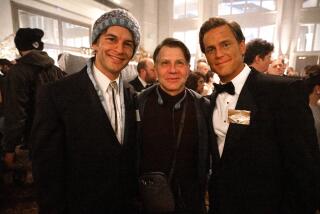Perspectives on Modern Gay Life :...
‘There is no such thing as a homosexual person, any more than there is such a thing as a heterosexual person,” Gore Vidal has insisted in essay after essay, decade after decade. “The words are adjectives describing sexual acts, not people.” Vidal may have logic on his side, but he surely knows it counts for little in a culture addicted to discrimination in every form. As much as he would like to think of sexuality in terms of adjectives, nouns rule the world.
In 1869, a Hungarian journalist named Karoly Benkert coined the terms “homosexual” and “heterosexual” for the express purpose of pathologizing the former. As the new century progressed, the effect of this division became clear. Sexual lives that had been sporadically persecuted but largely ignored were now legally criminalized and socially silenced. Religious zealots and political hacks found a new “other” to denounce. Organized crime profited by catering to “deviants,” bribing the police in order to do so. Blackmailers flourished. And worst of all, there were the psychiatrists.
“In [the psychiatric] view, which was mainstream America’s view made professional and scientifically unassailable, homosexuality was an abnormality to be corrected at all costs,” writes Alan Helms in his recently published memoir, “Young Man From the Provinces.” “The most barbarous treatments were justified in the name of destroying such pernicious tendencies.”
In 1969, 100 years after Benkert’s divide, an uprising at a New York gay bar, the Stonewall Inn, formally protested the police-Mafia alliance and enabled a sexual minority to find its voice. By 1973, the psychiatric auto da fe had ended. Soon a host of plays, poems, novels, manifestoes, biographies and historical studies began to be written by the former outcasts. They described gay lives having little to do with the “strange twilight world” of pre-Stonewall fiction or gender-role obsessed psychoanalytic “case histories.” Still, self-consciousness doesn’t always lead to self-knowledge, as shown by two recent novels that attempt to put modern gay life in perspective in light of the AIDS epidemic.
“Why isn’t having been spared sufficient to make one happy? Why isn’t that enough?” asks Lark, the surnamed-only protagonist of Andrew Holleran’s “The Beauty of Men.” It’s a fair question, but the author isn’t prepared to answer it. A character in Holleran’s 1976 paean to New York’s disco era, “Dancer From the Dance,” Lark now lives in Gainesville, Fla., where he cares for his invalid mother, cruises a local men’s room, obsesses over a one-night stand he vainly imagines is the love of his life and moans endlessly about being lonely, friendless and a victim of early hair loss. As one whiny, self-pitying page follows another, even the least flamboyant of readers may be moved to scream, “Oh, Mary, get a grip!”
“When you admit you are homosexual, when you come out, you feel you are striking a blow for life,” Lark declares at one point. “But further down the road . . . you have to face the fact that you are basically left with nothing.” If you’ve lived like Lark, with self-worth completely tied to physical attractiveness, this is certainly true. But there’s no reason to see such masochistic self-aggrandizement as the exclusive province of gay men, as Holleran seems to imply.
Brad Gooch creates a similar dead end in his marvelously--but misleadingly-titled, “The Golden Age of Promiscuity.” Instead of examining the full panoply of same-sex interchange, Gooch limits himself to the scene that once flourished in the after-hours clubs of New York’s Lower West Side. If you want to know what went on inside the Anvil and the Mineshaft, “Golden Age” is nothing if not thorough. But if you’re interested in more important aspects of gay life in the ‘70s you won’t find them in this tale of Sean, an “experimental” pornographer who sees himself as “a big ear, left rocking lopsidedly on the floor like a child’s toy, adding little, absorbing much.” As Sean is given to muttering such vacuous non sequiturs as, “You erase the false in me,” it’s clear that this “ear” is deaf to all but its own interests.
Taking his cue from Truman Capote, Gooch confects scenes in which real people like gay activist Morty Manford, “Studio 54” owner Steve Rubell, photographer Robert Mapplethorpe, painter Joe Brainard and New York’s most incurable diseuse, Dorothy Dean, interact with his hero. But “Golden Age” is no “Answered Prayers,” as shown in the final chapter, where Sean meets Gaetan Dugas. Apparently Gooch finds the HIV-infected French-Canadian airline steward--immortalized as “Patient Zero” in Randy Shilts’ questionable account of the early years of the epidemic, “And the Band Played On”--to be the ultimate celeb. If he meant his book to be one long sick joke, with Dugas as its punch line, then Gooch has succeeded. But he doesn’t provide the insight into same-sexuality he offered in “City Poet,” his biography of Frank O’Hara. The latter was an evocation of pre-Stonewall gay life better than any--short of Helms’ “Young Man From the Provinces.”
Ordinarily it wouldn’t be fair to pit works of fiction and fact against one another. But in the case of Helms’ beautifully written memoir, it’s unavoidable. Like Gooch’s Sean, Helms sped through the celebrity-packed fast lanes of the ‘60s and ‘70s. Like Holleran’s Lark, he’s lost friends to AIDS and much of his hair. But unlike either of those characters--or their creators--he’s learned how to stand back and get some perspective.
A Midwestern small town sissy who felt he could never “fit in” to “normal” life, Helms arrived in New York in the late 1950s to discover “a world of men like me.” All it took was an invitation to a gay “A-list” cocktail party, and this literal nobody found himself best pals with Noel Coward, Leonard Bernstein and Luchino Visconti; in time, he was having love affairs with Anthony Perkins, Larry Kert and every other good-looking gay New Yorker who wasn’t already spoken for (plus quite a few who were).
“I didn’t analyze my experiences at the time, I just lived them,” says Helms, on the discovery that his boyish good looks could get him anything or anyone he wanted. The picture he paints of a world untouched by the problems visited upon less-privileged gays is hilarious (the Leonard Bernstein anecdote alone is worth the price of the book). But it’s also insightful, particularly when Helms underscores the almost total lack of social consciousness within his social set, even after Stonewall. For Helms the turning point came in the ‘70s, after destructive affairs and substance abuse had taken their toll:
“Leaving the subway one night, I saw a man walking toward me and thought, ‘Not bad but not good. A far cry from the GQ guys who used to be my daily fare. No one I’d give a second glance.’ I then realized I was looking at my own reflection in a plate glass window.”
Today, Helms is a professor of American literature at Boston University specializing in Walt Whitman. He isn’t mourning for his lost beauty. He’s not given to self-righteous contrition for his sybaritic past. He isn’t “in a relationship” either. He’s just a middle-aged gay man trying to live life as best he can in spite of AIDS, Freud, Benkert and even Gore Vidal.
More to Read
Sign up for our Book Club newsletter
Get the latest news, events and more from the Los Angeles Times Book Club, and help us get L.A. reading and talking.
You may occasionally receive promotional content from the Los Angeles Times.






